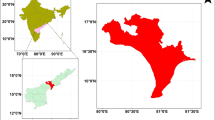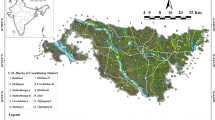Abstract
Flood susceptibility mapping is required for assessing flood risk areas and developing flood prevention techniques. The Thamirabarani river basin, a flood-prone area in the Tamil Nadu region of Srivaikundam, was investigated. Flood risk assessment using a composite risk and vulnerability index is a well-established tool that plays an important role in the development of flood risk reduction schemes. The present research is an attempt to analyze flood risk using analytical hierarchy procedures in a geographic information system context, which includes flood hazard components and susceptibility indicators. Geographic information system (GIS) are currently a trusted and useful tool for defining flood susceptibility maps at various spatial scales. The accuracy of various GIS-based flood risk assessment techniques is compared in this article. Land use and land cover, drainage density, topographic wetness index, distance from rivers, river length, slope, DEM, and rainfall were the eight foundation layers that were generated from the geographical database. All of the thematic layers and the resulting flood frequency map were combined to create the flood susceptibility using a GIS platform. Flood-vulnerable areas have been classified as very low class (1.7%), low class (26.3%), medium class (42.1%), high class (24%), and very high class (5.9%). The flood susceptibility study with this model will be a very beneficial and efficient tool for creating flood mitigation measures, according to local government administrators, researchers, and planners.











Similar content being viewed by others
References
Abdel Hamid HT, Wenlong W, Qiaomin L (2020) Environmental sensitivity of flash flood hazard using geospatial techniques. Glob J Environ Sci Manag 6(1):31–46
Ahmed A, Hewa G, Alrajhi A (2021) Flood susceptibility mapping using a geomorphometric approach in South Australian basins. Nat Hazards 106(1):629–653. https://doi.org/10.1007/s11069-020-04481-z
Bajabaa S, Masoud M, Al-Amri N (2014) Flash flood hazard mapping based on quantitative hydrology, geomorphology and GIS techniques (case study of Wadi Al Lith, Saudi Arabia). Arab J Geosci 7:2469–2481. https://doi.org/10.1007/s12517-013-0941-2
Dandapat K, Panda GK (2017) Flood vulnerability analysis and risk assessment using analytical hierarchy process. Model Earth Syst Environ 3:1627–1646. https://doi.org/10.1007/s40808-017-0388-7
Das S (2020) Flood susceptibility mapping of the Western Ghat coastal belt using multi-source geospatial data and analytical hierarchy process (AHP). Remote Sens Appl Soc Environ. https://doi.org/10.1016/j.rsase.2020.100379
Elkhrachy I (2015) Flash flood hazardmapping using satellite images and GIS tools: a case study of Najran City, Kingdom of Saudi Arabia (KSA). Egypt J Remote Sens Space Sci 18(2):261–278. https://doi.org/10.1016/j.ejrs.2015.06.007
Ghosh A, Kar SK (2018) Application of analytical hierarchy process (AHP) for flood risk assessment: a case study in Malda district of West Bengal. India Nat Hazards 94(1):349–368. https://doi.org/10.1007/s11069-018-3392-y
Gokceoglu C, Sonmez H, Nefeslioglu HA, Duman TY, Can T (2005) The 17 March 2005 Kuzulu landslide (Sivas, Turkey) and landslide-susceptibility map of its near vicinity. Eng Geol 81(1):65–83
Hammami S, Zouhri L, Souissi D, Souei A, Zghibi A, Marzougui A, Dlala M (2019) Application of the GIS based multi-criteria decision analysis and analytical hierarchy process (AHP) in the flood susceptibility mapping (Tunisia). Arab J Geosci 12(21):1–16. https://doi.org/10.1007/s12517-019-4754-9
Hong H, Tsangaratos P, Ilia I, Liu J, Zhu AX, Chen W (2018) Application of fuzzy weight of evidence and data mining techniques in construction of flood susceptibility map of Poyang County, China. Sci Total Environ 625:575–588. https://doi.org/10.1016/j.scitotenv.2017.12.256
Khosravi K, Nohani E, Maroufinia E, Pourghasemi HR (2016) A GIS-based flood susceptibility assessment and its mapping in Iran: a comparison between frequency ratio and weights-of-evidence bivariate statistical models with multi-criteria decision-making technique. Nat Hazards 83(2):947–987. https://doi.org/10.1007/s11069-016-2357-2
Malik S, Pal SC, Das B, Chakrabortty R (2020) Assessment of vegetation status of Sali River basin, a tributary of Damodar River in Bankura District, West Bengal, using satellite data. Environ Dev Sustain 22(6):5651–5685. https://doi.org/10.1007/s10668-019-00444-y
Nagaraju K, Varma PST, Varma BR (2011) A current-slope based fault detector for digital relays. In: 2011 Annual IEEE India conference, pp 1–4. IEEE
Natarajan L, Usha T, Gowrappan M, Palpanabhan Kasthuri B, Moorthy P, Chokkalingam L (2021) Flood susceptibility analysis in chennai corporation using frequency ratio model. J Indian Soc Remote Sens 49(7):1533–1543. https://doi.org/10.1007/s12524-021-01331-8
Nath A, Saha G (2018) River length calculation using map data. In: Proceedings of the international conference on computing and communication systems: I3CS 2016, NEHU, Shillong, India. pp 821–828. Springer, Singapore. https://doi.org/10.1007/978-981-10-6890-4_78
Rangarajan S, Thattai D, Cherukuri A, Borah TA, Joseph JK, Subbiah A (2019) A detailed statistical analysis of rainfall of Thoothukudi district in Tamil Nadu (India). In: Water resources and environmental engineering II. Springer, Singapore, pp 1–14. https://doi.org/10.1007/978-981-13-2038-5_1
Saaty TL (1980) The analytical hierarchy process. McGraw-Hill, New York
Samanta S, Pal DK, Palsamanta B (2018) Flood susceptibility analysis through remote sensing, GIS and frequency ratio model. Appl Water Sci 8(2):1–14. https://doi.org/10.1007/s13201-018-0710-1
Shrivastava D, Nath, A, Saha G (2018) River length calculation using map data. In: Proceedings of the international conference on computing and communication systems: I3CS 2016, NEHU, Shillong, India. Springer Singapore, pp 821-828
Subbarayan S, Sivaranjani S (2017) Modelling of flood susceptibility based on GIS and analytical hierarchy process—a case study of Adayar River Basin, Tamilnadu, India. In: International expert forum: mainstreaming resilience and disaster risk reduction in education. Springer, Singapore, pp 91–110. https://doi.org/10.1007/978-981-32-9527-8_6
Sudalaimuthu K, Jesudhas CJ, Ramachandran U, Somanathan AK, Ganapathy S, Jeyakumar RB (2022) Development of digital elevation model for assessment of flood vulnerable areas using Cartosat-1 and GIS at Thamirabarani river, Tamilnadu, India. Environ Qual Manag. https://doi.org/10.1002/tqem.21842
Swain KC, Singha C, Nayak L (2020) Flood susceptibility mapping through the GIS-AHP technique using the cloud. ISPRS Int J Geo Inf 9(12):720. https://doi.org/10.3390/ijgi9120720
Yaralıoğlu K (2004) Analitik Hiyerarşi Proses. Uygulamada Karar Destek Yöntemleri, İlkem Ofset, İzmir
Acknowledgements
The First author expresses his sincere thanks to Shri. A.P.C.V. Chockalingam, Secretary and our Principal Dr. C. VeeraBhahu, V.O.Chidambaram College, Thoothukudi. The help was extended by Dr. P. Sivasubramanian, Professor and Head, PG and Research Department of Geology, V.O.Chidambaram College, Thoothukudi.
Funding
There is no funding source for this study.
Author information
Authors and Affiliations
Contributions
RAS was involved in conceptualization and methodology, writing—original draft preparation and writing—review and editing. ARA contributed to supervision, writing—review and editing and resources.
Corresponding author
Ethics declarations
Conflict of interest
The authors declare that they have no conflict of interest.
Consent to participate
Not applicable.
Consent to publish
Not applicable.
Ethical approval.
Not applicable.
Additional information
Publisher's Note
Springer Nature remains neutral with regard to jurisdictional claims in published maps and institutional affiliations.
Rights and permissions
Springer Nature or its licensor (e.g. a society or other partner) holds exclusive rights to this article under a publishing agreement with the author(s) or other rightsholder(s); author self-archiving of the accepted manuscript version of this article is solely governed by the terms of such publishing agreement and applicable law.
About this article
Cite this article
Selvam, R.A., Antony Jebamalai, A.R. Application of the analytical hierarchy process (AHP) for flood susceptibility mapping using GIS techniques in Thamirabarani river basin, Srivaikundam region, Southern India. Nat Hazards 118, 1065–1083 (2023). https://doi.org/10.1007/s11069-023-06037-3
Received:
Accepted:
Published:
Issue Date:
DOI: https://doi.org/10.1007/s11069-023-06037-3




